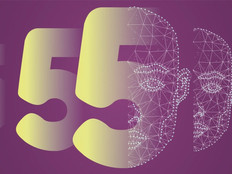Hazardous Conditions Ahead
DMVs need to be wary of sharp curves in modernization plans thanks to Real ID.
In many states, Billy Clair Killingsworth could easily have passed as one of the millions of law-abiding Americans who applies for a driver’s license each day. But as Killingsworth stood at the counter waiting for his application to be processed, Alabama’s licensing office system revealed the truth. Killingsworth, who had been serving a life sentence on charges that he kidnapped and raped a 10-year-old girl, had escaped from a New Mexico prison 14 years earlier and was trying to obtain an Alabama license using a fake Social Security card and Florida license.
Alabama is one of the few states in the nation that checks applicant information against the FBI’s National Crime Information Center system before issuing driver’s licenses and identification cards. It makes between 3,000 and 5,000 felony arrests each year, often based on NCIC matches.
“Alabama is a leader in the country as far as establishing and maintaining the security of our driver’s licenses,” says Maj. Roscoe Howell, chief of Alabama’s Driver License Division.
Nearly all of Alabama’s licensing processes — on both the front and back ends — are electronically integrated in one system. Citizens take computerized tests; their records are captured electronically; their digital photos are stored in a searchable database; and their names are automatically checked against national databases to confirm identity and ensure they are legally entitled to a license. That puts Alabama ahead of the curve when it comes to complying with the Real ID Act, a law aimed at creating more secure driver’s licenses and identification cards across the nation.
Even so, Alabama’s licensing officials, like their counterparts in other states, have serious concerns about meeting the mandates of Real ID. The law, which takes effect May 11, 2008, requires among other things that states verify identity documents using systems that don’t yet exist or aren’t available nationally. It’s an already tight timeline exacerbated by the fact that the law’s regulations have yet to be released.
“It’s hard for us to look into the crystal ball,” says David Quam, director of federal relations for the National Governors Association. “With that May 2008 deadline rapidly approaching, it’s a big problem. We’ve got more questions than answers until we see those regulations.”
What is Real ID?
The 19 men who hijacked planes on Sept. 11, 2001, had easily passed through airport security with valid U.S. driver’s licenses. The terrorists had obtained some of these licenses using fake documents and by turning to states with lenient licensing policies. That prompted Congress to pass the Real ID Act of 2005 as part of a large emergency spending bill.
The intent of Real ID, the implementation of which is being overseen by the Department of Homeland Security (DHS), is twofold: tighten the nation’s borders and strengthen the security of driver’s licenses and other state-issued identification.
A means to that end is to have departments of motor vehicles verify the authenticity of identity documents submitted by license applicants. Instead of just asking to see a birth certificate and a utility bill as proof of address, a DMV official would have to check with the county clerk’s office that issued the birth certificate and the utility company to make sure the documents are authentic. The problem is that many identity documents are provided by institutions that either don’t keep electronic records or don’t make those records available to anyone outside their organizations.
Real ID also requires states to check one another’s records so that people can’t get multiple licenses from different states. But there is no database of U.S. license holders, and with different back-end systems and processes in each state, it would be a massive undertaking to connect states’ disparate databases.
“I think it’s safe to say that everyone’s surprised at how complicated these systems are,” says David Quam, director of federal relations for the National Governors Association. “States have evolved their systems over 100 years, and DHS is trying to do this in three.”
Another major concern is Real ID’s stipulation to recredential all existing license holders within five years of the May 2008 implementation deadline. So, in addition to issuing licenses to new drivers, the nation’s DMVs will need to validate and reissue licenses and IDs to people already holding such documents.
Senate legislation introduced in December would provide annual funding to help states comply with Real ID, extend the deadline and safeguard existing state and federal privacy laws.
“This is going to touch everybody, 245 million license holders,” Quam says. “That means that all the political branches are going to have an eye on Real ID.”
Special Delivery
Identity thieves and frauds are no match for Kentucky’s digital driver’s license photo system. The database automatically searches every picture in the system daily, analyzing 16 features, including facial hair, cheek bone structure and eye color. If two photos have enough similarities, they’re included on a list for employees to review. The system once nabbed a man who had obtained 13 driver’s licenses using different aliases.
The system likely helped Kentucky get selected as one of two pilot states to receive federal Real ID grants. The facial-recognition system proves that technology exists to help secure driver’s licenses, says David Jackson, deputy commissioner and chief of staff for the Kentucky Transportation Cabinet. It’s just a matter of finding time and money to implement such systems nationally, he says.
“I think the technology’s there to create a secure ID,” Jackson says. “The issue for us is the delivery.”
To make licenses comply with Real ID, Kentucky must bring new systems online, hire additional employees to recredential existing license holders, train and get clearance for employees, and provide physical security at offices. Doing all that for the 140 county circuit clerk offices that issue driver’s licenses in the state is cost-prohibitive, Jackson says.
The state has considered creating mobile driver’s license units that rotate throughout regions rather than making every licensing office compliant, he says.
Technologically speaking, Kentucky’s biggest thorn is its antiquated COBOL mainframe, which the Transportation Cabinet is seeking funding to replace. Re-engineering the system to comply with Real ID would be an ordeal, Jackson says.
Despite the challenges, Kentucky is ahead of many states in preparing for Real ID for a variety of reasons:
- It doesn’t offer online licensing (states that do will likely have to stop to comply with Real ID’s verification requirements).
- Its searchable digital photo system already provides the fraud protections envisioned for Real ID.
- Citizens already must go into motor-vehicle offices every four years to renew their licenses — so recredentialing could be achieved in a reasonable timeframe.
- The state issues birth certificates centrally, so it will only need to interact with one agency to verify in-state birth information.
Although Kentucky issues birth certificates centrally, the documents aren’t available in a searchable database. But the state is now working to connect to the Electronic Verification of Vital Events (EVVE) system, a federal computerized birth-certificate verification system being piloted in some states.
Real ID; Real Concerns
A joint report from the National Governors Association, National Conference of State Legislatures and American Association of Motor Vehicle Administrators (AAMVA) estimates that implementation of the Real ID Act will cost state governments more than $11 billion over five years.
The three organizations based their report, “The Real ID Act: National Impact Analysis,” on a nationwide survey of state departments of motor vehicles. According to the report, Real ID will have “a major impact on services to the public and impose unrealistic burdens on states to comply with the act.”
States must implement the first of the 2005 law’s requirements by May 11, 2008 and reissue driver’s licenses and identification cards to the nation’s 245 million current holders within five years. The law also demands that states establish onsite identification verification procedures and meet specific data security and card production requirements.
Among the recommendations outlined in the report is a request that the federal government extend the compliance deadline, provide funds necessary to comply with Real ID and grant the secretary of Homeland Security the flexibility to recognize innovation at the state level.
“State groups, including DMVs and the AAMVA, have offered the Homeland Security Department what we believe to be common-sense solutions that can help save our drivers time and money,” says Jason King, vice president of public relations for AAMVA. “So we are hopeful that our recommendations will be adopted.
Mapping Compliance
Just after Real ID was signed into law in 2005, Alabama officials, who were determined to be among the first states to comply, sat down with the state’s licensing contractor, Digimarc of Beaverton, Ore., to create a road map toward Real ID compliance, Driver License Division Chief Howell says.
First, the team listed the areas in which the state was already compliant, such as taking and storing digital license photos, only permitting principal addresses on licenses, incorporating machine-readable technology on licenses and verifying credentials with the Social Security Administration.
Next, they identified goals the state could achieve with little money or adverse impact, Howell says. One example is checking applicants against the Systematic Alien Verification for Entitlements system, which verifies citizenship and immigration status. The state has been preparing to incorporate SAVE checks into its processes for years, so it’s on the way to complying with that element of the law.
The Alabama team then penciled in items that would need clarification and hinge on the final federal regulations, such as whether states would be required to verify documents such as utility bills and bank statements. “When the law was written, I don’t think anybody contacted the major utilities,” Howell says, explaining that the verification requirement would be a major expense for his organization.
The final category included goals that officials thought were impossible to achieve, such as verifying birth certificates. With thousands of sources of birth certificates, many of which do not use electronic records, there’s no way a system could be created to electronically verify birth certificates by 2008, Howell says.
Even the EVVE system, which only a few states are using, has run into problems as states try to computerize all birth records created since 1935. (Real ID grandfathers licenses of people born before then.)
“That’s really just a no-brainer,” Howell says. “It’s not going to happen.”
Some State-driven Real ID Recommendations
Millions of DMV Transactions

Real ID requirements would more than double the typical annual workload of state DMVs, according to an ID and license transactions review done for “The Real ID Act: National Impact Analysis” report.
“The Real ID Act: National Impact Analysis,” a joint report from the National Governors Association, National Conference of State Legislatures and American Association of Motor Vehicle Administrators, makes three radical suggestions:
- Implement a 10-year, progressive re-enrollment and allow reciprocity for ID holders already vetted by the federal government. To re-enroll the nation’s 245 million existing license and ID holders within five years of May 2008 will cost $8.48 billion nationally because of the need for additional employees, extended hours and efficiencies lost by discontinuing online and mail renewals.
- Develop verification systems at the federal level and require states to comply with the verification requirement only as systems become available. New verification processes will require $1.42 billion nationally to cover system development, programming, testing and training expenses.
- Permit a variety of security formats. Many states already have acceptable security features in place and complying with a single federally designated technology to prevent card tampering and counterfeiting will cost $1.11 billion nationally.
Southern Detour
Virginia residents can renew their driver’s licenses, replace titles and order new plates online. Close to 65 percent of the state’s vehicle registrations are Internet transactions.
“For some of that front-end stuff, I think we’ve been pioneers,” says Virginia Department of Motor Vehicles Commissioner D.B. Smit. On the back end, however, “we’ve got a lot of work to do before we catch up.”
The Virginia DMV has begun planning for a complete redesign of its back-end systems as part of a broader business transformation process that initially had a three- to five-year timeline. But like modernization efforts around the country, Virginia’s plans have been complicated by the Real ID May 2008 deadline.
“We think we’re moving right now as fast as we possibly can, but Real ID wants us to make a quantum leap,” Smit says.
States are at different levels of preparedness in efforts to comply with the law, says Jason D. King, director of public affairs for the American Association of Motor Vehicle Administrators in Arlington, Va. But even the most advanced states have plans to further modernize their systems.
For instance, in Alabama, nearly the entire driver’s licensing process is captured in a tightly integrated electronic system. Road tests are one exception. The state would like to issue handheld computers to those giving road tests so that the results are instantly incorporated into drivers’ electronic records, says Maj. Roscoe Howell, chief of the Alabama Driver License Division.
Virginia, on the other hand, is just starting to update many of its processes. This fall, the DMV installed the first four PCs in customer-service centers. Until now, it had used green-screen dumb terminals, says Smit.
Putting PCs on the front counters will help with the Real ID mandates, he adds. But some of the law’s requirements have the potential to create a tremendous burden on the department. The plan to recredential existing license holders would bring in 1 million citizens to Virginia’s customer-service centers each year, forcing the state to make significant changes to accommodate them.
Despite the challenges, Smit feels that some of the elements of Real ID, such as verifying that applicants aren’t licensed in other states, make sense. The problem is time and money, he says.
“No one’s coming up with any money for this,” Smit says. “And I just don’t see it getting done by May 11, 2008.”






